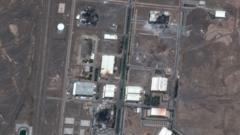The fourth day of confrontations between Israel and Iran surged on June 16, 2025, as Israeli military forces announced significant airstrikes targeting the elite Quds Force’s headquarters in Tehran. Confirmations of this attack remain unverified, yet it coincided with a new wave of Iranian missile strikes—reportedly hitting several cities in Israel and contributing to the death toll of at least eight individuals. As anxiety escalates for civilians on both sides, the situation appears to be rapidly deteriorating without signs of a ceasefire.
**Escalating Conflict: Israel Launches Major Airstrikes on Iranian Military Facilities Amid Ongoing Missile Exchanges**

**Escalating Conflict: Israel Launches Major Airstrikes on Iranian Military Facilities Amid Ongoing Missile Exchanges**
The ongoing Israeli-Iranian conflict intensifies as Israel claims to have struck the Quds Force’s command center in Tehran, coinciding with Iranian missile attacks that have resulted in civilian casualties in Israel.
Israel has reportedly engaged in the most extensive military assaults yet seen in the decades-long hostility with Iran, with strikes that have caused considerable destruction and casualties within Iran. Official reports reveal at least 224 deaths and over 1,400 injuries in Iran since attacks commenced on Friday, alongside at least 24 fatalities in Israel due to Iranian retaliatory missile strikes. Focused initially on military and nuclear sites, Israeli operations are now extending toward Iran’s energy infrastructure.
As this conflict unfolds, civilians in both nations are increasingly vulnerable, with reports of long lines of cars fleeing Tehran and the frantic search for shelter among Israelis reacting to missile alerts. The current wave of conflict is being characterized by a lack of clarity regarding its trajectory, as both nations persist in their military objectives with seemingly little diplomatic engagement in sight.
The broader implications of these military engagements raise concerns of escalating regional hostilities, potentially drawing in external powers like the United States. While Iranian officials have vowed to defend their territory, Israel is determined to dismantle Iran’s capabilities, specifically targeting its nuclear aspirations.
**With no resolution in sight, this ongoing strife showcases the fragility of regional stability, as both sides brace for further escalations.**
As this conflict unfolds, civilians in both nations are increasingly vulnerable, with reports of long lines of cars fleeing Tehran and the frantic search for shelter among Israelis reacting to missile alerts. The current wave of conflict is being characterized by a lack of clarity regarding its trajectory, as both nations persist in their military objectives with seemingly little diplomatic engagement in sight.
The broader implications of these military engagements raise concerns of escalating regional hostilities, potentially drawing in external powers like the United States. While Iranian officials have vowed to defend their territory, Israel is determined to dismantle Iran’s capabilities, specifically targeting its nuclear aspirations.
**With no resolution in sight, this ongoing strife showcases the fragility of regional stability, as both sides brace for further escalations.**






















